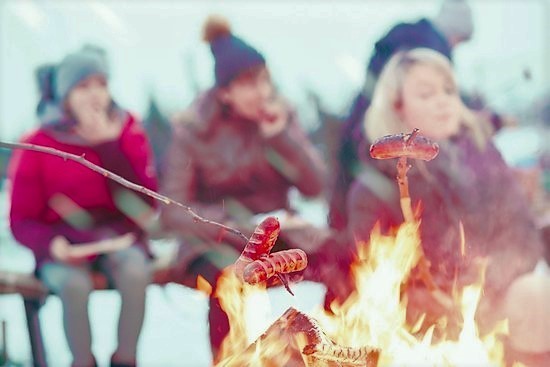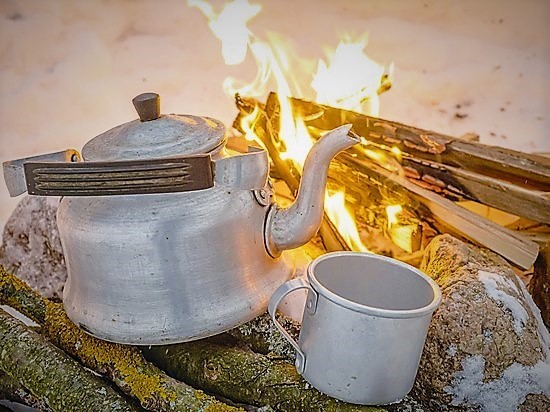You are standing amid snow-covered
mountains in the early morning, the sun
creeping over jagged, ice-blue peaks. Your breath visible, you wrap your gloved
hands around a mug of piping hot tea. All around you is silence — many birds
have left for the season, other creatures are hibernating. It’s a peace you
achieved by deciding to sleep out in the cold winter elements in all of their
beautiful, painful glory.
اضافة اعلان
Welcome to the wonderful world of winter
camping.
Making the intentional choice to sleep outdoors in the winter months provides
nature enthusiasts the chance to extend their camping season or explore the
wilderness with a lot less company — benefits, they say, that are well worth
the additional preparation and camping gear the activity requires. And just
like warm-weather camping, there is a huge range of winter-camping experiences
that people from novices to extreme athletes can try — from testing the waters
with backyard or car camping to luxury guided tours to extended backcountry
adventures requiring skis or snowshoes.
 (Photo: Envato Elements)
(Photo: Envato Elements)
“The wilderness in the
winter is really unlike
anything else,” said Noah Howell, a backcountry adventure skier based in Salt
Lake City who loves camping in Alaska. “It’s magical.”
‘My favorite way to camp’
While millions of people
have discovered or rediscovered a love of camping during the pandemic,
especially in the balmy summer months, the willingness to take in the outdoors
at subzero temperatures can be a head-scratcher for some.
“Winter camping probably best fits in the category
of ‘fun when it’s done,’” said Howell. “It often provides that feeling of
relief from having survived something challenging.”
The first step is getting over that initial mental
hurdle.
“It’s definitely nerve-wracking to go to spend a
night on the cold, frozen ground,” said Cody Townsend, a professional skier who
lives in Tahoe City, California. “But these days, honestly, it’s my favorite
way to camp.”
Townsend isn’t alone in his enthusiasm.
“There are no bugs, no mud, and mostly, no people,”
said Mark Eis, a live events consultant in New Paltz,
New York, and a volunteer
instructor with the ADK Winter Mountaineering School, a nonprofit that teaches
in-person winter camping, hiking and introductory mountaineering courses. In
addition to exploring the Adirondacks, he enjoys trips to Baxter State Park in
Maine. “The mountains are just unspeakably beautiful in the winter. Even when
it’s not as much fun, when it feels like work, I just have to pick my head up
and look around.”
 (Photo: Envato Elements)
(Photo: Envato Elements)
Access is another major selling point for winter
campers.
“You can sleep with your tent facing Half Dome,”
said Sanjay Reddy, a wastewater engineer in Dublin,
California, who loves
camping in Yosemite National Park and other spots in the Sierra Nevada and is
chair of the Sierra Club’s snow-camping program. “In the summer, they won’t
even let you camp there! Not to mention there are tons of people.”
Unique challenges
Understanding the unique
challenges that come with winter camping, and taking the time to plan and
prepare, is vital to making the experience enjoyable and safe. Things can get
dangerous much more quickly when it’s cold.
“Your planning skills have to be much more honed in
the winter than in the summer,” said Reddy. “In the summer, you can just walk
onto a marked trailhead, in shorts. You can find water. You can sleep without a
tent and probably be okay.”
In addition to cold temperatures, there can be
unexpected snowstorms, less daylight, and less visibility. It’s often
significantly harder to navigate in the snow — trails, markers, and even
landmarks may be covered up. Depending on the terrain, there may be a risk of
avalanches.
Making safety a priority is important in any outdoor
adventure but is perhaps all the more pressing in the snow. Reddy recounted
forgetting his camping stove on a summer backpacking trip. While not ideal — he
subsisted on cold backpacker’s meals — it was far from a life-or-death crisis.
In the winter, it would have been a different story.
Fortunately, there are plenty of tricks to stay
warm, from lightweight hand warmers in your sleeping bag to a Nalgene bottle
filled with boiling water wrapped in socks inside a jacket.
“If people know they have the opportunity to get
warm, they’ll enjoy the cold a lot more,” said Joe Meyer, who with his wife,
Mollie Foster, runs Traverse Alaska, a Denali Park, Alaska-based outdoor
adventure company. “It goes from, ‘I’m miserable,’ to ‘I’m going to stay
outside and enjoy the Northern Lights a bit longer, even though it’s 20 below
zero.’”
 (Photo: Envato Elements)
To get started
(Photo: Envato Elements)
To get started
No matter your level of
camping expertise, signing up for winter-specific classes or instruction is a
wise first step. Courses offered through the ADK Winter Mountaineering School,
the Sierra Club and other wilderness organizations often combine classroom
time, learning about compass and map navigation, what to pack, and safety
skills, with trips of varying lengths on the ground to test out what you’ve
learned in the elements. (Avalanche safety courses are highly recommended
should you want to level up your winter camping game).
You can ease into the elements, too.
“Try camping in your own backyard to start,” said
Alysa Arnold, a stay-at-home mother and entrepreneur who splits her time
between Concord, Massachusetts, and Saratoga Springs, New York, and is
assistant director of the ADK Winter Mountaineering School. “I’ll do that with
my kids, and if it doesn’t work, we can just go back inside.”
Guided trips, like those led by Meyer and Foster in
Alaska, are excellent resources for those who want to explore farther afield
and don’t want to go it alone. Additional trips can be found just about
anywhere you’re interested in winter camping, including Utah, Colorado, Oregon,
Vermont, Canada, Norway’s Svalbard archipelago and more.
Many organizations, including the Winter
Mountaineering School and the Sierra Club offer resources online, not only for
best practices but also suggestions for the appropriate gear, including
clothing and cook stoves.
“People think the cold is your enemy, but it’s not.
The wet is your enemy,” said Eis, referring to a common pitfall of layering too
much when snowshoeing, hiking, or skiing, which leads to sweating. Wearing moisture-wicking,
quick-drying materials, including synthetics, wool and fleece, is key, as is
avoiding cotton.
A sleeping bag appropriate for cold weather is a
must, as is a lightweight camp stove, fuel (the Sierra Club recommends white
gas for winter camping), and camping cookware to melt snow for water and make
hot food and drinks. A backup fire starter, like a lighter or waterproof
matches, is also a requirement. Depending on your trip, snowshoes, skis, axes
or crampons might be needed. Retailers like Eastern Mountain Sports, Sports
Basement and REI rent hiking and camping equipment, from apparel to tents.
Other gear recommended by experts: down booties, two
sleeping pads to insulate from the cold snow, and a hat (or two). And Howell
highly encourages a clearly labeled pee bottle to keep in your tent at night to
avoid the dreaded middle-of-the-night bathroom trip. (Ladies can experiment
with options like the aptly named Shewee.)
Easily accessible snacks are necessary — you can
expect to burn more calories in the cold — and choose bars or other food that
are easy to eat and won’t freeze.
Learning to conquer the elements in more extreme
conditions better prepares you for summer camping, too — particularly when it
involves surprise inclement weather.
“My summer skills have gotten better because of my winter
skills,” said Reddy. “Maybe you’ll go on a trip early in the summer season and
you come across snow. Guess what? Now, you know how to deal with it.”
Read more Travel



